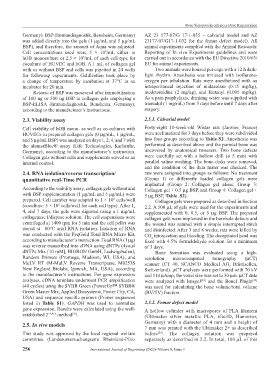Page 264 - IJB-8-3
P. 264
Bone Sialoprotein enhances Bone Regeneration
Germany). BSP (Immundiagnostik, Bensheim, Germany) AZ 23 177-07/G 17-1-055 – calvarial model and AZ
was added directly into the gels (1 μg/mL and 5 μg/mL 23177-07/G17-1-032 for the femur defect model). All
BSP), and therefore, the amount of Aqua was adjusted. animal experiments complied with the Animal Research:
Cell concentrations used were 5 × 10 /mL either in Reporting of In vivo Experiments guidelines and were
5
hOB monoculture or 2.5 × 10 /mL of each cell type for carried out in accordance with the EU Directive 2010/63/
5
coculture of HUVEC and hOB. A 1 mL of collagen gel EU for animal experiments.
with or without BSP and cells was pipetted in 24 wells Two animals were housed per cage with a 12 h dark-
for following experiments. Gelification took place by light rhythm. Anesthesia was initiated with isoflurane-
a change of temperature by incubation at 37°C in an oxygen per inhalation. Rats were anesthetized with an
incubator for 20 min. intraperitoneal injection of midazolam (0.15 mg/kg),
Release of BSP was measured after immobilization medetomidine (2 mg/kg), and fentanyl (0.005 mg/kg).
of 100 ng or 500 ng BSP in collagen gels employing a As a pain prophylaxis, drinking water was supplied with
BSP-ELISA (Immundiagnostik, Bensheim, Germany), tramadol (1 mg/mL) from 3 days before until 7 days after
according to the manufacturer’s instructions. surgery.
2.3. Viability assay 2.5.1. Calvarial model
Cell viability of hOB mono- as well as co-cultures with Forty-eight 10-week-old Wistar rats (Janvier, France)
HUVECs in prepared collagen gels (0 μg/mL, 1 μg/mL, were acclimatized for 3 days before they were subdivided
and 5 μg/mL BSP) was analyzed on days 1, 2, 4, and 7 with into four groups according to Table S2. Anesthesia was
the alamarBlue® assay (Life Technologies, Karlsruhe, performed as described above and the parietal bone was
Germany), according to the manufacturer’s instruction. uncovered by anatomical tweezers. Two bone defects
Collagen gels without cells and supplements served as an were carefully set with a hollow drill (ø 5 mm) with
internal control. parallel saline washing. The bone disks were removed,
and the condition of the dura mater was checked. The
2.4. RNA isolation/reverse transcription/ rats were assigned into groups as follows: No treatment
quantitative real-Time PCR (Group 1) or differently loaded collagen gels were
implanted (Group 2: Collagen gel alone, Group 3:
According to the viability assay, collagen gels without and Collagen gel + 0.5 μg BSP, and Group 4: Collagen gel +
with BSP supplementation (1 μg/mL and 5 μg/mL) were 5 μg BSP, Table S2).
prepared. Cell number was adapted to 1 × 10 cells/well Collagen gels were prepared as described in Section
6
(coculture: 5 × 10 cells/well for each cell type). After 1, 2.2. A 500 μL of gels were used for the experiments and
5
4, and 7 days, the gels were digested using a 1 mg/mL supplemented with 0, 0.5, or 5 μg BSP. The prepared
collagenase I/dispase solution. The cell suspensions were collagen gels were implanted in the borehole defects and
centrifuged at 1400 rpm for 5 min and the cell pellet was the wound was sutured with a simple interrupted stitch
stored at −80°C until RNA isolation. Isolation of RNA and disinfected. After 3 and 8 weeks, rats were killed by
was conducted with the PeqGold Total RNA Micro Kit, CO intoxication and bleeding. The decapitated head was
2
according to manufacturer’s instruction. Total RNA (1 μg) fixed with 4.5% formaldehyde solution for a minimum
was reverse transcribed into cDNA using dNTPs (4you4 of 3 days.
dNTPs Mix [10 mM], BIORON GmbH, Ludwigshafen), Bone formation was evaluated using a high-
Random Primers (Promega, Madison, WI, USA), and resolution microcomputed tomography (μCT)
MuLV RT (M-MuLV Reverse Transcriptase, M0253S scanner (CT 40, SCANCO Medical AG, Brüttisellen,
New England Biolabs, Ipswich, MA, USA), according Switzerland). μCT analyses were performed with 70 kV
to the manufacturer’s instructions. For gene expression and 114 μAmp, the voxel size was set to 30 μm. μCT data
analyses, cDNA template underwent PCR amplification were analyzed with ImageJ and the BoneJ Plugin
[34]
[33]
(40 cycles) using the SYBR Green (PowerUp™ SYBR® was used for calculating the bone volume/total volume
Green Master Mix, Applied Biosystems, Foster City, CA, (BV/TV) fraction.
USA) and sequence specific primers (Primer sequences
listed in Table S1). GAPDH was used to normalize 2.5.2. Femur defect model
gene expression. Results were calculated using the well- A hollow cylinder with macropores of PLA filament
established 2 −ΔΔCt method . (Ultimaker silver metallic PLA, iGo3D, Hannover,
[32]
2.5. In vivo models Germany) with a diameter of 4 mm and a height of
7 mm was printed with the Ultimaker 2+ as described
This study was approved by the local regional welfare before [26] . The collagen solution was prepared
committee (Landesuntersuchungsamt Rheinland-Pfalz separately as described in 2.2. In total, 100 μL of this
256 International Journal of Bioprinting (2022)–Volume 8, Issue 3

